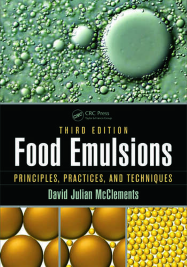Food Emulsions Principles Practices and Techniques
Material type: TextLanguage: English Publication details: Boca Raton, FL : CRC Press, c2016Edition: 3rdDescription: XXIII, 690 p. : illISBN:
TextLanguage: English Publication details: Boca Raton, FL : CRC Press, c2016Edition: 3rdDescription: XXIII, 690 p. : illISBN: - 9781498726689
- 664 MCC
| Item type | Current library | Shelving location | Call number | Copy number | Status | Date due | Barcode |
|---|---|---|---|---|---|---|---|
 Reference Collection
Reference Collection
|
Reference Section | Department of Food Engineering | 664 MCC | 2022-23 | Available | 98040 |
Biography
David Julian McClements is a professor in the Department of Food Science at the University of Massachusetts. He specializes in the areas of food biopolymers and colloids, particularly the development of food-based structured delivery systems for bioactive components. Dr. McClements received his Ph.D. in Food Science (1989) from the University of Leeds. He then did post-doctoral research at the University of Leeds, University of California, Davis, and University College Cork. His research has been funded by grants from the U. S. Department of Agriculture, National Aeronautics and Space Administration (NASA), National Science Foundation, U.S. Department of Commerce, and the food industry. He is a member of the editorial boards of a number of journals, and has organized workshops, symposia, and conferences in the fields of food colloids, food emulsions, and delivery systems.
SUMMARY:
Continuing the mission of the first two editions, Food Emulsions: Principles, Practices, and Techniques, Third Edition covers the fundamentals of emulsion science and demonstrates how this knowledge can be applied to control the appearance, stability, and texture of emulsion-based foods. Initially developed to fill the need for a single resource covering all areas of food emulsion formation, stability, characterization, and application, the first two editions raised the bar for references in this field. This third edition is poised to do the same.
See What’s New in the Third Edition:
New chapters have been added on Emulsion-Based Delivery Systems and the Gastrointestinal Fate of Emulsions
All chapters have been revised and updated, including new methods of fabricating and characterizing emulsions
New figures have been included, and previous ones have been redrawn
As in previous editions, the main focus of this book is on presenting the fundamental principles of emulsion science and technology that underlie all types of emulsion-based food products. It highlights practical applications and provides an overview of modern areas of research. Figures and diagrams add emphasis to important concepts and present the underlying theory in a clear and approachable manner. These features and more give you a firm grounding in basic principles that will aid in the rational design of new products, the improvement of existing products, and the more rapid solution of processing problems.
